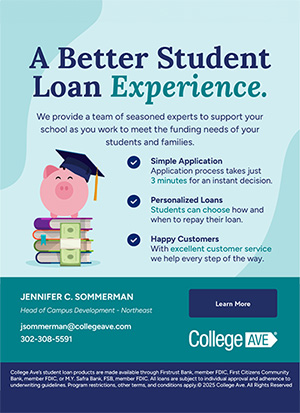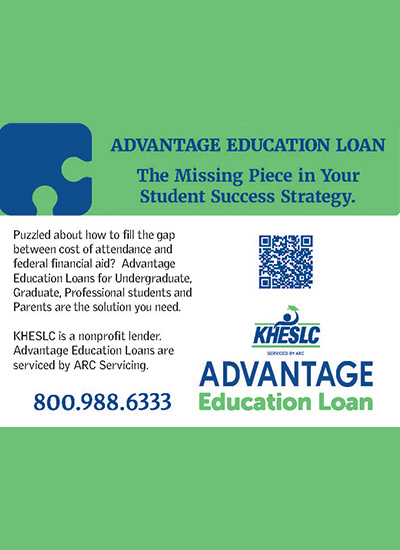Financial Aid Terms, Abbreviations, and AcronymsClick on the letter of the alphabet to jump to that section: A | B | C | D | E | F | G | H | I | J | K | L | M | N | O | P | Q | R | S | T | U | V | W | X | Y | Z To view just a list of acronyms, click here. A Academic Credit – The unit of measurement an institution gives to a student when the student completes the institution’s course or subject requirements. Academic Year – A period of time, defined by the school, which measures the academic work to be accomplished by the student. Federal regulations set minimum standards for the purpose of determining SFA awards. For instance, the academic year at a term school must be at least two semesters, two trimesters, or three quarters and must include at least 30 weeks of instructional time. Unlike the award year, an academic year does not have to begin and end at the same time for all students. One student might enroll as a full-time student in September and complete one academic year of study in May, while another student might enroll as a half-time student in January and take twice as long to complete an academic year. Acceptance Form – Written acknowledgment by the student of receipt of the award letter. The form usually provides for acceptance of offered aid, possible declination of all or part of the package, and some means of requesting an appeal, if that is desired, to modify the award. Accrued Interest – Accumulated interest charged on the unpaid principal balance. ACT – American College Testing Program Advanced Placement AP – Credit and/or advanced standing in certain course sequences that postsecondary institutions may offer to high school students who have taken high level courses and passed certain examinations. Adjusted Available Income – The portion of family income remaining after deducting federal, state, and local taxes, a living allowance, and other factors used in Federal Methodology. AGI - Adjusted Gross Income – All taxable income. Taken from the U.S. Tax return. APTS - Aid For Part-Time Study – State grant program provides grant assistance for eligible part-time students enrolled in approved undergraduate studies in New York State. Assets – Cash on hand in checking, savings, trust, stocks, bonds, other securities; i.e., real estate, income producing property, business equipment, and business inventory is considered in determining expected family contribution. Assistantship and Wages – Both types of aid provide funds to students in exchange for services. Institutional definitions should be used to distinguish between them. Associate’s Degree – A degree given for successful completion of some courses of study at a two-year institution. Award Letter – A means of notifying financial aid applicants of the assistance being offered. The award letter usually provides information on the types and amounts of aid offered, as well as specific program information, student responsibilities and the conditions which govern the award. The letter provides students with the opportunity to accept or decline the aid offered. Award Year – The award year begins on July 1st of one year, and extends to June 30 of the next year. Funding for the Federal Pell Grant and campus-based programs are provided on the basis of the award year, thus a student is paid out of funds designated for a particular award year, such as the 2007-2008 award year. B Budget – The estimated cost of attendance for an institution; usually includes tuition, fees, books, supplies, room, board, personal expenses and transportation. Other expenses may be included (see Cost of Attendance). Bureau of Indian Affairs (BIA) Grants – A grant program for students who are one-quarter or more Indian, Eskimo, or Aleut and are enrolled in accredited institutions in pursuit of an undergraduate or graduate degree. Financial need must be demonstrated, as determined by the institution the student will attend. Business Assets – Property that is used in the operation of a trade or business, including real estate, inventories, buildings, machinery and other equipment, patents, franchise rights, and copyrights. Considered in determining a family’s expected contribution. Byrd Scholarship – A federally sponsored, merit-based scholarship for outstanding high school students. C Capitalization – A loan arrangement whereby you may add unpaid interest to the principle, rather than pay the interest when it is due. CD - College Discovery – A program for educationally and economically disadvantaged students at 2-year CUNY units. CEEB - College Entrance Examination Board – An institutional membership organization which includes CSS. The CEEB administers the SAT and other testing programs. Central Processing System (CPS) – The Department’s processing facility for application data. The CPS receives student information from the FAFSA processors, calculates the student’s official EFC, and returns the student’s information to the FAFSA processor, which prints the Student Aid Report (SAR). Certificate – The formal acknowledgement of successful completion of a particular program or course of study, particularly at a vocational school, trade school, or junior college. Citizen/Eligible Non-Citizen – Students must be one of the following to receive federal student aid: U.S. Citizen; U.S. national (includes natives of American Samoa or Swain’s Island); U.S. permanent resident who has an I-151, I-551, or I-551C (Alien Registration Receipt Card). Collection Agency – A business organization that accepts, from lenders, loan accounts that have become delinquent or are in default, and attempts to collect on those accounts. A fee is charged for the service. College Level Examination Program (CLEP) – A series of examinations demonstrating a student’s proficiency in a subject area, for which some postsecondary institutions offer credit. College Scholarship Service (CSS) – A financial aid service provider. Colleges contract with CSS to provide application and processing for institutional aid. College Work-Study Program – See Federal Work-Study. Commercial Lender – A commercial bank, savings and loan association, credit union, stock savings bank, trust company or mutual savings bank. Commuter Student – A student who is not a resident student; typically “commuter” refers to a student living at home with his or her parents while attending college. Consolidation – Combining all of your federal student loans under one repayment plan. Consolidation Loan – A loan made to a student when an eligible lender pays off his/her existing student loans and creates one new loan. Students can combine certain eligible Federal student loans into one loan and increase their repayment time frame 10 to 30 years depending on the balance. FFEL students must be out of school. Direct loan students can consolidate while they are still in school. Co-Signer – A second credit-worthy party who is required to sign a promissory note for a loan with a borrower. This party guarantees the loan will be repaid if the borrower defaults. Cost of Attendance (also known as Cost of Education or Budget) – The student’s cost of attendance includes not only tuition and fees, but the student’s living expenses while attending college. The cost of attendance is estimated by the school, within guidelines established by federal regulations. The cost of attendance is compared to the student’s expected family contribution to determine the student’s need for aid. Credit Bureaus – Organizations that maintain records on your financial history. There are currently three major credit bureaus: TRW, Inc.; Equifax Credit Information Services; and TransUnion. Credit (or Credit Hour) – The unit of measurement some institutions give for fulfilling course requirements. CUNY – City University of New York. Custodial Parent – The parent with whom a dependent student lives, and whose financial information is used in need analysis when parents are divorced or separated. D Default – Failure to repay a loan in accordance with the terms of the promissory note. May also result from failure to submit requests for deferment or cancellation on time. If one defaults, the school, the organization that holds the loan, the state, and the federal government can all take action to recover the money, including notifying national credit bureaus of your default. This may affect students’ credit rating for a long time. Deferment of Loan – A condition during which payment of principal are not required, and for Perkins and Subsidized Stafford Loans, interest does not accrue. The repayment period is extended by the length of the deferment period. Delinquent – To be overdue on one or more payments on a loan. Department (ED or USED) – Abbreviation for the U.S. Department of Education. Dependent Student – A student who must use parental information on the financial aid application based on dependency criteria, established by the funding source. A student who does not qualify as an independent student. (See Independent Student) Disbursement – The process by which financial aid funds are made available to students for use in meeting educational and related living expenses. Disclosure Statement – Statement of disclosure regarding certain conditions of loans. Such disclosures must be made each time a loan commitment is made. E Educational Benefits – Funds, primarily federal, awarded, to certain categories of students (veterans, children of deceased or other deceased wage earners, and students with physical handicaps) to help finance their postsecondary education regardless of their ability to demonstrate need in the traditional sense. Educational Expenses – See Cost of Attendance EFC - Expected Family Contribution – For the calculation of Federal Title IV aid. Eligible Institution – An institution of higher education, a vocational school, or a postsecondary vocational institution, or a proprietary institution of higher education which is approved for participation in the federal student aid programs by the U.S. Department of Education and/or for New York State programs by the New York State Education Department. Eligible Program – A program of education or training which complies with the procedures established in regulations governing the Title IV programs. The eligibility of a program determines whether a student in that program can receive federal financial assistance. A course of study leading to a degree or certificate at a school participating in one or more of the student aid programs. Eligible Aid Applicant – An eligible aid applicant is a regular student (as defined below) who meets all of these five criteria:
E-MPN – Electronic version of the Master Promissory Note. Enrollment Status – At those institutions using semesters, trimesters, quarters or other academic terms and measuring progress by credit hours, enrollment status equals a student’s credit hour workload categorized as either full-time, three quarter-time, half-time, or less than half time. Entitlement Program – Program which is not dependent upon institutional allocations, and which is funded sufficiently to ensure that all eligible applicants will receive awards. As long as the student applicant meets all the eligibility requirements and is enrolled in an eligible program at an eligible institution, he/she will receive the award for which eligibility has been established. Entrance Counseling – Conducted before release of the first disbursement of the first Federal Stafford Loan made to the borrower. The counseling is done in person, or by videotape presentation. A person knowledgeable about Student Financial Aid programs must be available for questions after the counseling session. EOP - Educational Opportunity Program – a specialized program of admissions and financial aid at SUNY state-operated colleges. Estimated Financial Assistance (EFA) – The amount of student financial aid the student can expect from federal, state, school, or other sources, including grants, loans, or need-based work programs. The school uses this estimate when certifying loan applications. ETS - Educational Testing Service – this agency supplies technical expertise and analysis to CEEB and CSS, including need analysis. Exceptional Financial Need – An eligibility criterion in the SEOG and Perkins Loan Programs. Exceptional financial need for SEOG is defined in statute as the lowest expected family contribution at an institution. The law does not define the term in the Perkins Loan Program. Exit Counseling – Conducted to advise the student of loan repayment information before he/she enters repayment. The counseling is done in person, or by videotape presentation. Expected Family Contribution (EFC) – The amount the student’s family is expected to contribute towards the cost of attendance, for the purpose of the Student Financial Aid programs. The EFC is printed on the front of the Student Aid Report. F FAFSA – See Free Application for Federal Student Aid FAFSA Processor – The agency that distributes and processes the FAFSA under contract with the Department of Education. Federal Direct Stafford Loan (Subsidized and Unsubsidized) – Same as a Federal Stafford Loan, funds come directly to the college from the federal government, eliminating the bank, credit union or other lender. Some aspects of the application process may be different. Federal Direct PLUS Loan – Long-term loans made available to parents of dependent students attending colleges that participate in the Federal Direct Stafford Loan Program. Interest rates are linked to 52-week Treasury bill rates, buy rates, but may not exceed 9%. May be used to replace EFC; amount borrowed is limited to the cost of attendance minus estimated financial assistance. Federal Family Education Loan Programs (FFELP) – The Federal Stafford (subsidized and unsubsidized), Federal PLUS and Federal Consolidation loan programs. Funds for these programs are provided by commercial lenders and credit unions. The loans are guaranteed by a guaranty agency and the federal government. Federal Methodology – The method used in determining eligibility for federal student aid programs. Federal Pell Grant – Are awarded to undergraduate students based on financial need as demonstrated on the FAFSA. Federal Perkins Loan – A low-interest (5%) loan to help students pay for their education. These loans are for both undergraduate and graduate students with exceptional financial need, as determined by the school. For undergraduate students, priority is given to Federal Pell Grant recipients. Federal Perkins Loans are made through a college’s financial aid office. Federal PLUS Loan - Federal Parent Loan for Undergraduate Students – Parents borrow to help pay for their children’s education. This loan is made to the parent by a bank, credit union or savings and loan association. Interest rates are fixed at 8.5%. May be used to replace EFC. Federal Stafford Loan (Subsidized and Unsubsidized) – Low-interest loans that are made to students attending college at least half-time. Loans are made by a bank, credit union, or savings and loan association. These loans are insured by the guaranty agency in each state and reinsured by the federal government. The federal government pays the interest on the loan while the student is in college (subsidized), or the student is responsible for paying the interest (unsubsidized). The fixed interest rate for loans made after July 1, 2006 is 6.8%. Repayment rates will vary between the subsidized and unsubsidized loans under this program. Federal Supplemental Educational Opportunity Grants (FSEOG) – One of the campus-based programs; grants to undergraduate students of exceptional financial need who have not completed their first baccalaureate degree and who are financially in need of this grant to enable them to pursue their education. Priority for SEOG awards must be given to Pell Grant recipients. Federal Work-Study – Provides part-time employment to students attending institutions of higher education who need the earnings to help pay the cost of their postsecondary education. FWS gives students an opportunity to earn money to help pay educational expenses. The program encourages community service work. Fellowship – A grant or money for postgraduate study which may require teaching or research. Financial Aid Administrator (FAA) – An individual who is responsible for preparing and communicating information pertaining to student loans, grants or scholarships, and employment programs, and for advising, awarding, reporting, counseling, and supervising office functions related to student financial aid. He/she is accountable to the various publics which are involved, is a manager or administrator who interprets and implements federal, state and institutional policies and regulations, and is capable of analyzing student and employee needs and making changes where necessary. Financial Aid Award – An offer of financial or in-kind assistance to a student attending a postsecondary educational institution. This award may be in the form of one or more of the following types of financial aid: Repayable loan, a non-repayable grant and/or scholarship, and/or student employment. Financial Aid Consultant – A person who, for a fee, provides a variety of services to students and parents, including preparing the FAFSA and other financial aid forms, finding forms of financial aid, estimating the Expected Family Contribution (EFC), and estimating financial need. Financial Aid Notification – The letter from a postsecondary institution that lets the student know whether or not aid has been awarded. If the student will be receiving assistance, the notification also describes the financial aid package. State agencies and private organizations may send students financial aid notifications separately from the postsecondary institution. Also see Award Letter. Financial Aid Profile – The original input document (aid application) in the College Scholarship Service’s system of need analysis. Used by some colleges to award institutional aid. Financial Aid Package – The combination of financial aid funds (loans, grants, scholarships, and employment) awarded to an individual student by the college. Financial Need – The difference between the student’s cost of attendance and the expected family contribution. FM – See Federal Methodology. Forbearance – A temporary cessation of repayment of loans allowing an extension of time for making loan payments, or accepting smaller loan payments than were previously scheduled. Foreign Student – A student belonging to or owing allegiance to another country. Foreign students are not eligible for the basic federal programs, although there are categories of non-U.S. citizens who owe permanent allegiance to the United States and are eligible for student aid. Free Application for Federal Student Aid (FAFSA) – The application for federal student aid, filled out by the student that collects household and financial information used to calculate the expected family contribution. Full-Time Student – Generally, one who is taking a minimum of 12 semester or quarter hours per academic term in institutions with standard academic terms, or 24 clock hours per week in institutions which measures progress in terms of clock hours. G Gift Aid – That form of financial aid which does not require repayment or require that work be performed. Grace Period – The period of time that begins when a loan recipient ceases to be at least half-time and ends when the repayment period starts. Loan principal need not be paid and interest does not accrue during this period. Graduate or Professional Student – A student enrolled in an academic program of study above the baccalaureate level at an institution of higher education. Graduated Payments – A flexible rescheduling of your loan payments that allows you to make payments of different amounts. (Available through consolidation) Grants – Are awards for which there is no expectation of repayment or services to be performed. Great Lakes Higher Education Corporation – A private guaranty agency for student loans obtained through lending institutions. Guaranty Agency – A State agency or private, non-profit institution or organization which administers Federal Family Education Loans, provides application, insurance, and collection services. In New York State, the guaranty agency is New York State Higher Education Services Corporation (HESC). H Hardship – A period of financial difficulty that may allow you to delay repayment of a loan or to decrease monthly payments. Health Professions Student Loan (HPSL) Program – A long-term, low interest loan program designed to assist students in specific health and human services professions. HEOP - Higher Education Opportunity Program – a specialized program of admission and financial aid at independent (non-public) colleges and universities. HESC - New York State Higher Education Services Corporation – This state agency administers New York State’s grant, and scholarship awards, and is New York State’s guaranty agency for the Federal Family Education Loan Programs. I Income Protection Allowance – An allowance to meet the subsistence expenses of a family, including food, shelter, clothing, and other basic needs. Used in federal need analysis formula. Independent Student – For federal student aid purposes, students who meet at least one of the following criteria:
Institution – A postsecondary educational institution. The terms, “school/college” and “institution” may be used interchangeably to refer to postsecondary educational institutions. Institutional Aid – Financial aid available through the school. Usually consists of grants and/or scholarships. Institutional Methodology – An alternative methodology used by some commercial need analysis processors (CSS) and also by some institutions (mostly private) to determine eligibility for institutional funds such as grants and scholarships. ISIR - Institutional Student Information Report – A form that is sent to the student’s school. Similar to the Student Aid Report that is sent to the student; the ISIR contains the family’s financial information and indicates the student’s eligibility for aid. Interest – The fee charged to borrow money. The student pays their lender interest in addition to repaying the principal (the sum borrowed). Usually, interest is calculated as a percentage of the principal and paid in monthly payments. IRS – Internal Revenue Service. Internships – Part-time or full-time opportunities to gain professional work experience while in college. Some interns are paid; others gain college credits; some offer both. Investment Plans – Educational savings programs, usually sponsored by commercial banking institutions or financial investment companies. New York’s plan is called, New York’s 529 College Savings Program. L Legal Guardian – An individual appointed by a court to be a legal guardian of a person and who is specifically required by the court to use his/her own financial resources to support that person. A legal guardian is not considered a parent. Lender – The party that gives you a loan, whether it be a bank, credit union, savings and loan association, a college, the government or another organization. Loans – Are awards made with a formal agreement for repayment with interest. M Matriculated – To be enrolled at an institution, working toward a degree or certificate in an eligible program. Merit Award – Financial Aid which is awarded based on demonstrated academic excellence, professional promise, and personal merit. Military Scholarships – Reserve Officer Training Corps (ROTC) scholarships available for the Army, Navy and Air Force at many colleges and universities throughout the United States. These scholarships cover tuition and fees, books and supplies, and include a subsistence allowance. N NACUBO – National Association of College and University Business Officers. NASEA – National Association of Student Employment Administration. NASFAA - National Association of Student Financial Aid Administrators – a national professional organization of FAA’s. National and Community Service – A program established through the National and community Service Trust Act of 1993 designed to reward individuals who provide community service with educational benefits and/or loan forgiveness or cancellation. National Health Service Corps (NHSC) Scholarships – Scholarship program for students who pursue full-time courses of study in health profession schools. Service Obligation required. National of the United States – A citizen of the United States or a non-citizen who owes permanent allegiance to the United States. Need Analysis – The process of analyzing the household and financial information on the student’s financial aid application and calculating an expected family contribution. A system used to estimate a student applicant’s need for financial assistance to help meet his/her educational expenses. Need analysis consists of two primary components: (a) determination of an estimate of the applicant’s and/or family’s ability to contribute to educational expenses; and (b) determination of an accurate estimate of the educational expenses. Need Analysis Document – The original input form completed by an applicant and family for one of the need analysis systems. The document is the foundation for all need analysis computations performed by the agency implementing a need analysis system. Need Analysis System (NAS) – A system (usually automated) that calculates an expected family contribution based on information the student reports on the FAFSA. Need–based Aid – Student assistance awarded because a student’s financial circumstances would not permit him or her to afford the cost of a postsecondary education. New York State Regents Professional Opportunity Scholarship Program – Scholarships available for full-time students studying an approved program leading to licensure in a profession designated by the Commissioner of Education. Applicants must be economically disadvantaged, members of a minority group historically under represented in the licensed professions, or a graduate of the State-sponsored EOP, HEOP, SEEK or College Discovery opportunity programs. Recipients must agree to practice in their licensed profession in New York State for one year for each year that the award is received. Non Need-based Aid – Aid based on criteria other that need, such as academic, musical, or athletic ability. Also, refers to federal student aid programs where the expected family contribution (EFC) is not part of the need equation. Non-Taxable Income – All income received that is not reported to the Internal Revenue Service or is reported but excluded from taxation. Such income would include but not be limited to any untaxed portion of Social Security benefits, welfare payments, untaxed capital gains, interest on tax-free bonds, IRA’s, Keogh, dividend exclusion, military and other subsistence and housing allowances, retirement contributions and child support. NSLDS - National Student Loan Data System – The U.S. Department of Education’s central database for student aid. Students can access information on loan or grant amounts, outstanding balances, the status of their loans, and disbursements. Nursing Student Loans (NSL) – Loans available to nursing students attending approved nursing schools offering a diploma, associate degree, baccalaureate, or graduate degree in nursing. NYSFAAA - New York State Financial Aid Administrators Association – A professional state organization of financial aid administrators. O Origination Fee – A fee charged by the federal government, deducted from the principal that serves as an insurance against loan default. Over award – Generally, any amount of campus-based aid or a Federal Family Education Loan that exceeds the student’s financial need. (The Over award concept does not apply to the Federal Pell Grant Program.) Overpayment – Any payment of a Federal Pell Grant, Federal SEOG, or SSIG that exceeds the amount for which the student was eligible, whether the overpayment is the result of an over award an error in the cost of attendance or the Expected Family Contribution, or any other eligibility criterion, such as citizenship or enrollment in an eligible program. P Parent – The student’s natural mother, father, or legal guardian; an adoptive parent is considered to be the student’s mother or father as is the stepparent. A legal guardian is not considered a parent. Parent Loans – See Federal PLUS Loan. Parental Contribution – Quantitative estimate of the parent’s ability to contribute to postsecondary educational expenses. Part-Time Student – One who attends an institution on less than a full-time basis as defined by the institution. Payment Schedule – The schedule published annually by the Secretary of Education which enables financial aid administrators to relate the Pell Grant cost of attendance to the EFC, in order to determine the student’s Pell Grant award. PC – See Parental Contribution. Pell Grant – An entitlement program for undergraduate students (See Federal Pell Grant). Perkins Loan – See Federal Perkins Loan PHEAA - Pennsylvania Higher Education Assistance Agency – A state guarantee agency for student loans obtained through lending institutions. PIN – Personal Identification Number – Issued by the U.S. Department of Education. The PIN serves as an identifier to provide electronic access to personal federal student aid information. PLUS – See Federal PLUS Loan. Postsecondary School – Technically, this term refers to any educational institution providing educational services beyond the level of high school. In daily usage, the term is often used to refer to non-higher educational institutions such as proprietary schools, trade and technical schools, and a range of non-traditional facilities as well as colleges and universities. Prepayment – The act of paying back part or all of a loan before the final payment is due. Most borrowers make regular monthly payments on their loans, but if you can pay ahead of schedule, you will be able to save some interest charges. Primary Care Loan – Federal Scholarship and Loan Program for students in specified health profession fields of study. Principal – Face value of the loan or the amount upon which interest is charged. Professional Judgment – While the method for determining student’s need for federal student aid is defined in the law, the law does give the financial aid administrator’s professional judgment. Professional judgment can be used in three areas:
These adjustments must be made on a case-by-case basis, and the reasons for the adjustment must be documented in the student’s file. Professional Student – See Graduate Student Promissory Note – The binding legal document you sign when you get a student loan. It lists the conditions under which you’re borrowing and the terms under which you agree to pay back the loan. It includes information on how interest is calculated and what the deferment and cancellation provisions are. R Refund – The amount due a student who withdraws or fails to pursue his/her course of study when funds have been paid to the institution. When an institution determines that a student is due a refund, if that student has received financial aid funds, a portion of the refund must be allocated to the program(s) from which the student received aid. Regular Student – A person who is enrolled or accepted for enrollment at an institution of higher education for the purpose of obtaining a degree or certificate. Renewal FAFSA – FAFSA filed by an applicant who applied for federal financial aid in the previous year. Filed on line, the Renewal FAFSA is pre-filled with applicant information that is not expected to change from one year to the next. Repayment Schedule – A plan, which should be attached to the promissory note at the time a borrower, ceases at least half-time study, which sets forth the principal and interest due on each installment and the number of payments required to pay the loan in full. It should include the interest rate, the due date of the first payment, and the frequency of payments. Resident Student – A student who does not live at home (with parents or guardian) during the academic year. An off-campus resident student is one who does not live in the institutionally-provided housing. An on-campus resident student is one who lives in housing facilities owned and/or maintained by the institution. Resources – Other student aid that must be taken into account to prevent an over award as defined in the regulations for the campus-based programs. ROTC Scholarship Program – Competitive scholarship that pays for tuition, fees, books, and a monthly living stipend and other benefits in exchange for participating in drills and classes during the academic year, military camp during the summer, and upon graduation, full-time active duty in the military for at least four years. S SAT – Scholastic Aptitude Test Satisfactory Academic Progress - (SAP) – Progress required of a financial aid recipient according to the school’s approved published policy. Scholarship – A form of financial assistance which does not require repayment or employment and is made to a student who demonstrates or shows potential for distinction at an institution, usually in academic performance, the arts or athletics. Scholarships for Disadvantaged Students (SDS) – A federal scholarship program designed to assist disadvantaged students enrolled in health profession institutions. Scholarships for the Undergraduate Education of Professional Nurses (SUEPN) Grant – Scholarship program for students in professional nursing schools; service obligation required. Scholarship Search Services – Organizations that may help students find little-known and unused financial aid funds. Families who are interested is using such a service should carefully investigate the company first. School – A postsecondary educational institution approved by the U.S. Department of Education, including colleges, community colleges, universities, business or vocational schools, or BOCES. School Year – A period of time, generally not less than eight months, in which a full-time student would normally be expected to complete the equivalent of two semesters, two trimesters, three quarters or 900 clock hours. SED – State Education Department (New York). SEEK – Search for Elevation and Education Through Knowledge; a program for economically and educationally disadvantaged students who attend a 4-year CUNY college. Selective Service Registration – All male students 18 years old and born after December 31, 1959, must be registered with selective service in order to receive federal student aid. Self-Help Assistance – Funds provided through the work and effort of the student, including savings from past earnings, income from present earnings or a loan to be repaid from future earnings. Self-Help Expectation – The assumption that a student has an obligation to help pay for a portion of his/her education. See Student Contribution. Self-Help Need – The need for funds from work and loan sources. SEOG – See Federal SEOG. Servicer – A company hired by the lender to perform account services for its student loans. These services may include application and repayment processing, customer information, and accounting. SFA (Student Financial Aid) Programs – The programs administered by the Office of Student Financial Assistance within the U.S. Department of Education, namely, Federal Pell Grants, Federal Supplemental Educational Opportunity Grants, Federal Work-Study, Federal Perkins Loans, Federal Stafford Loans, (subsidized and unsubsidized), Federal PLUS Loans, State Student Incentive Grants, Byrd Scholarships, and Federal Consolidation Loans. Simplified Needs Test – The primary purpose of the simplified needs test is to make it easier for students from low-income households to fill out the Free Application for Federal Student Aid. If a student’s family taxed income or earned income is $49,999 or less and the relevant family members are non-tax filers or used a 1040A or 1040EZ to file their taxes, the student will fill out only the first part of the application. Students who use the simplified needs test generally receive a larger award. SMART - National Science and Mathematics Access to Retain Talent Grant – a grant from the Federal Government for U. S. Citizens who are full time (in their third or fourth academic year), and receive a Federal Pell Grant, have a cumulative GPA (each semester) of 3.0 on a 4.0 scale, and majoring in an eligible major as defined by the Secretary of Education. To view a list of these programs, please visit www.federalstudentaid.ed.gov. A student could receive up to $4,000 per year. SS – Social Security SSIG - State Student Incentive Grants – State grant programs for eligible students. Funding for the program comes from U.S. Department of Education. SSN – Social Security Number SSIG – State Student Incentive Grants – State grant programs for eligible students. Funding for the program comes from the U.S. Department of Education. In New York State, this federal grant is incorporated into the Tuition Assistance Program (TAP). Stafford Loan Program – See Federal Stafford Loan Program State Student Incentive Grant (SSIG) – Federal grants to states to stimulate the establishment of grant programs for postsecondary students with substantial financial need. In New York State, this federal grant is incorporated into TAP. Statement of Educational Purpose – Formerly known as the “Affidavit of Educational Purpose,” this document is signed by the student financial aid recipient indicating his/her agreement to use the financial aid funds awarded for the educational or educationally-related purposes only. Student Aid Report (SAR) – The federal “output document” printed by a FAFSA processor and mailed to the student. The SAR contains the family’s financial and other information as reported by the student on the financial aid application. The student can make corrections/update information on the SAR and submit it to the federal processor. The student’s eligibility for aid is indicated by the EFC printed on the front of the SAR. Schools receive an electronic version of the SAR from the FAFSA processor, called an ISIR. Student Aid Report Information Acknowledgment – A non-correctable one-page SAR. Students who file a FAFSA on the Web or who make corrections online to applicant information receive this acknowledgment. Student Contribution – A quantitative estimate of the student’s ability to contribute to postsecondary expenses for a given year. Student Expense Budget – See Cost of Attendance Subsidy – Refers to the federal government’s payment of interest on a borrower’s behalf until repayment of the subsidized loan begins, including authorized periods of deferment. SUNY – State University of New York SUSTA - State University Supplemental Tuition Assistance – To help with the difference between TAP and tuition at State-operated colleges for students whose families’ are eligible to receive a maximum TAP award and are subject to the $200 annual reduction, commonly referred to as the “Upper Cut.” T TAP - Tuition Assistance Program – A grant sponsored by New York State for New York residents attending an approved postsecondary institution in New York on a full-time basis. Range of awards is $275-$5,000. Applicants must meet income and residency eligibility. Apply using the FAFSA and the ETA or CUNY application (see ETA). Taxable Income – Income earned from wages, salaries and tips as well as interest income, dividend income, business or farm profits, and rental or property income. Three-Quarter Time Student – A student who is carrying at least a three-quarter-time academic workload as determined by the institution at which the student is enrolled, and which amounts to at least three-quarters of the workload of a full-time student. Title IV – Those Student Aid programs which are called “Title IV” programs are those which are authorized under the Title IV of the Higher Education Act of 1965, as amended. Funds for the Title IV programs are appropriated each year by Congress. The basic philosophy of the Title IV aid is that the family--the student, student’s spouse and parents--have the primary responsibility to pay for higher education expenses to the extent of their ability. Title IV Need Analysis – Is intended to include a consistent, fair evaluation of a family’s financial circumstances. Most Title IV programs require a student applicant to demonstrate financial need. Title VII Programs – Include: Federal Pell Grant, Federal Supplemental Educational Opportunity Grants (SEOG), State Student Incentive Grant (SSIG), Robert C. Byrd Honors Scholarship, Federal Work-Study (FWS), Federal Perkins Loan (formerly NDSL), Federal Stafford Loan (formerly GSL), Federal Unsubsidized Stafford Loans (formerly SLS) and Federal Parent Loans for Undergraduate students. Title VII – Financial aid programs administered by the Department of Health and Human Services. Title VII Programs – Include: Nursing Student Loans (NSL), Primary Care Loan (PCL), National Health Service Corps. Scholarships (NHSC), and Scholarships for Disadvantaged Students (SDS). Truth-in-Lending Statement – The document provided to loan recipients that delineates the interest rates and other information relative to the loan the student has received. The use of the statement is required by the Consumer Credit Act. The Title IV loan programs are exempt from compliance with Truth-in-Lending. Tuition Payment Plans – A Strategy by which payment for present costs of postsecondary education is extended into a future period of time. U Unmet Need – The difference between a specific student’s total available resources and the total cost for the student’s attendance at a specific institution. USA FUNDS - United Student Aid Group – A private guarantee agency for student loans obtained through lending institutions. Untaxed Income – All income received that is not reported to the Internal Revenue Service (IRS) or is reported but excluded from taxation. Such income would include but not be limited to any untaxed portion of Social Security benefits, Earned Income Credit, welfare payments, untaxed capital gains, interest on tax-free bonds, dividend exclusion, and military and other subsistence and living allowances. V Variable Interest Rate – Rate of interest tied to a treasury bill and changes periodically. Verification – A procedure whereby the school checks the information the student reported on the financial aid application, usually by requesting a copy of the tax returns filed by the student and, if applicable, the student’s spouse and parent(s). Many schools conduct their own form of verification. In addition, schools must verify students selected through the federal central processing system, following the procedures established by regulation. The contractor will print an asterisk next to the Expected Family Contribution (on the Student Aid Report) to identify students who have been selected for verification. VESID - Vocational Education Services for Individuals with Disabilities – A combined State and Federal program to provide training funds to eligible students. Veteran – A person who has served on active duty in the Army, Navy, Air Force, Marines or Coast Guard, and who was discharged other than dishonorably. Veterans are considered to be independent. There is no minimum length of service requirement. Veterans Educational Benefits – Assistance programs for veterans and service persons or dependents of veterans for education or training. Example: Montgomery GI Bill. Vocational Rehabilitation – Programs administered by State Department of Vocational Rehabilitation Services to assist individuals who have a physical or mental disability which is a substantial handicap to employment. W Work-Study – See Federal Work-Study |








